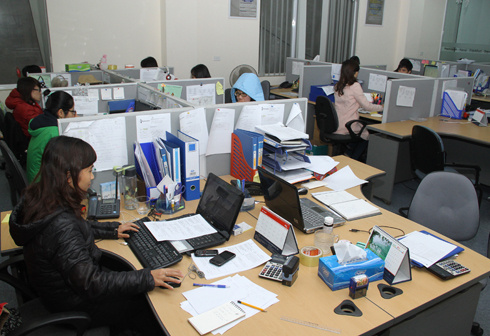Risk of poisoning of office workers (2)
The survey was carried out by a group of scientists from the Institute of Labor Science and Technology Research, found the presence of microorganisms, bacteria, mold, dust . in buildings and offices. .
>>> Therisk of poisoning of office workers
Rife of microorganisms
Mr. Ngo Quoc Khanh, Department of Environmental Technology, Center for Environmental Science and Sustainable Development, Institute of Science and Technology Research, Labor Protection said, when assessing the status of labor environment and health quality Workers in buildings and offices, the research team conducted analysis of factors related to microorganisms.
Accordingly, the research team collected microbiological parameters such as total aerobic bacteria, total 10cm diameter fungi were taken at least 1 meter from the floor 6 and wall for 15 minutes, then brought to the laboratory. Test to count the number of bacteria / fungi. The measurement results at 6 companies in 4 buildings in Hanoi showed that most offices and buildings are contaminated with microorganisms, indicators of total CKTM (hemolytic cocci) and total fungi are many times larger than the standard / recommended values.
This result is alarming because it is the source of pathological symptoms for employees working in the office. A number of common diseases have been reported with people living and working in the home related to microorganisms such as rhinitis, sinusitis, ear infections, pneumonia, asthma, contact dermatitis. .
In fact, the results of microbial microbial measurements in 3 of the 4 surveyed sites had a hemolytic bacteriophage index (mainly causing ENT and skin diseases) that exceeded the permitted standard. This source of coccidiosis is mostly caused by patients, healthy people carrying germs, especially from those with sore throat, amydal inflammation.

Dust due to surrounding construction
Because buildings are closed by glass doors, the dust intrusion from outside sources such as traffic and residential areas should be minimized . The measured value shows that the total dust concentration ranges from 0.069 - 0.506mg / m 3 and respiratory dust from 0.086 - 0.404mg / m 3 , except for one case with higher measurement values. The reason explained is that this building has just been put into use and there are many projects in the process of being built.
The survey results also show that, with the dust concentration measured at 6 companies and 4 buildings, compared to the sanitary standard of 3733/2002 / QD-BYT, total dust concentration and respiration are all low. A lot more times the value allowed. However, when compared to other foreign reference standards / guidelines, they are higher or approximate to the allowable value. In particular, when compared to Hong Kong's guidelines for concentration of indoor pollutants in 2003, both the total concentration of dust and respiratory dust were much higher.
Survey results show that respiratory dust affects the health of employees working here. The effect of dust on health depends on the nature, concentration and particle size. Dust can cause respiratory, gastrointestinal, eye, skin diseases . Small dust particles PM2.5 can penetrate the alveoli causing lung dysfunction.
- Risk of poisoning of office workers
- Shocked with the doll simulating office workers after 20 years
- Trees help increase the efficiency of office workers
- Workers should wash their hands often to protect themselves
- A savior has appeared to help office workers relieve stress
- Why should office workers stand up from their working chairs for at least 2 hours a day?
- Light is beneficial for the health of office workers
- The office also burns calorie like hunting
- E-mail made obese office workers
- Malicious office printers like cigarettes
- The extremely convincing scientific explanation for the phenomenon of eating is to be sleepy by office workers
- Good news for the people of the office
 Green tea cleans teeth better than mouthwash?
Green tea cleans teeth better than mouthwash? Death kiss: This is why you should not let anyone kiss your baby's lips
Death kiss: This is why you should not let anyone kiss your baby's lips What is salmonellosis?
What is salmonellosis? Caution should be exercised when using aloe vera through eating and drinking
Caution should be exercised when using aloe vera through eating and drinking